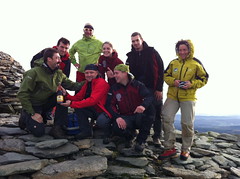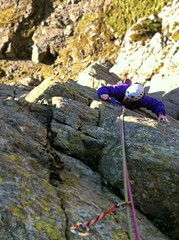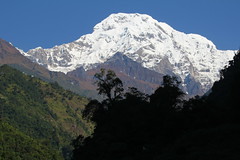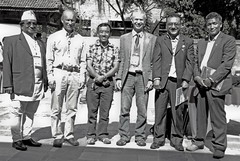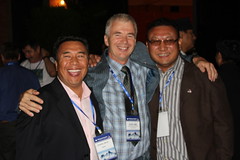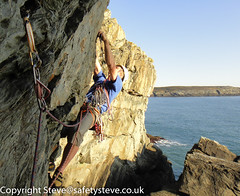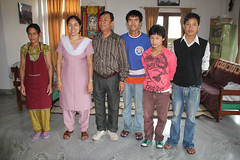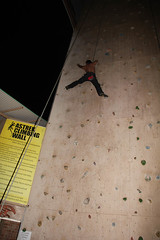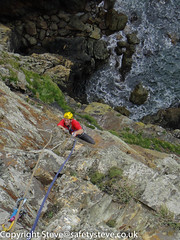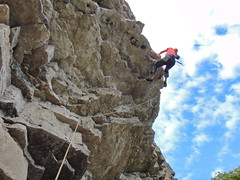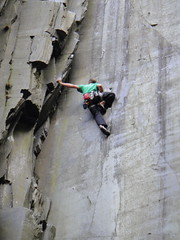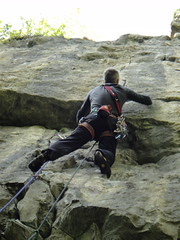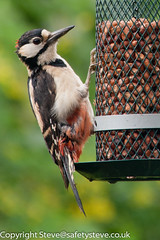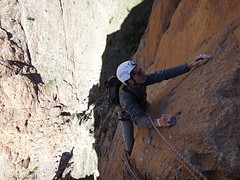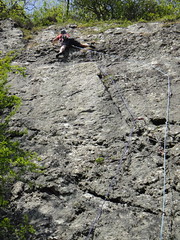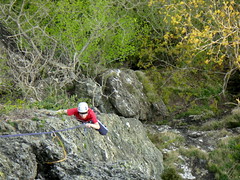North Wales climbing Academy, a set on Flickr.
Late November saw some interesting developments in the local coaching scene in North Wales. A selection event was held at the Beacon Climbing Wall, based around an informal competition. An academy of 20 talented young climbers was selected, based on a mixture of potential as individuals and as team players. This was followed by a FUNdamentals of Climbing 1 workshop delivered by Neil Johnson. There was a great atmosphere and excellent turn-out for both events. Some of the young climbers are half my height but can reach holds that I can't - I suspect its something they do with their feet or some other tricky stuff.Thursday 15 December 2011
Tuesday 13 December 2011
 |
| http://bdb.im/6p |
In early 2012, Mountain Leader Training will be launching a new website and online Candidate Management System. This sytem is a huge investment into the management of all our candidate details, and will bring all of your contact details, awards, CPD and membership details into one easy to use location. In order to contact as many of our candidates and members when we launch we need to check we have a valid email address for you. We are therefore asking if you could please complete and submit this short form http://bdb.im/6p so we can update these account details.
Please help us circulate this message to everyone in the Mountain Leader Community by sharing this message in as many places as you can, Forums, Websites, Email, Facebook, Twitter and of course word of mouth.
Saturday 3 December 2011
Algarve with GDAE
Algarve with GDAE, a set on Flickr.
What a privilege to attend this wonderful club's annual dinner in the Algarve! Perfect weather, wonderful hosts, excellent climbing. A magical weekend, over all too quickly! Meeting people like these is one of the great privileges of my role in the UIAA's Training Standards Working Group.
Wednesday 23 November 2011
Zirve Tutor Training
Zirve Tutor Training, a set on Flickr.
A highly successful course for 6 strong climbing instructors from the new UIAA member organisation, Zirve. Building from lessons learned on MIA training courses and the recent Train the Trainers course developed in partnership with Plas y Brenin, this course was delivered at Olympos, Turkey. Starting with sports climbing and a successful assessment of the candidates personal climbing standard, the course progressed on to teaching principles on progressively more difficult working environments, culminating in 2 new multi-pitch routes, one of which is destined for instant "classic" status at UIAA Grade IV+. Staffing the course were MLTUK's Steve Long and ENEQ's Ron Whitehead, with support from the Petzl Foundation.Friday 11 November 2011
Testament (6c+)
Chris Parkin and I headed over to one of our old stamping grounds - Chris is the N.Wales Bolt Fund Supremo but his heart is in adventure climbing. Today though was the blackest day I've ever seen without a physical downpour. We managed to climb 5 great routes (albeit slightly damp!) before the afternoon rain finally arrived. Yes, a real birthday treat for me!
Steve Long,11/11/11
Chris Parkin climbing this classic pitch at Pen Trwyn as storm clouds gather

Steve Long,11/11/11
Chris Parkin climbing this classic pitch at Pen Trwyn as storm clouds gather

Monday 7 November 2011
Old Man of Coniston
Spot the old man! International delegates take a day from the Annual General Assembly at the Bellview Hotel in Bowness on Windermere, to sample the delights of UK hill walking. They got a slightly unrealistic insight into the British fells with a cloudless and windless day. We followed the international tradition of shaking hands and sharing a bottle on the summit!
Pete Stacey, the Chair of MLTUK and myself had been invited to give a presentation about the relationship between MLT and the IML qualification, and opportunities presented by the UIAA Training Standards respectively. These appeared to be well received by the delegates - time will tell!
Pete Stacey, the Chair of MLTUK and myself had been invited to give a presentation about the relationship between MLT and the IML qualification, and opportunities presented by the UIAA Training Standards respectively. These appeared to be well received by the delegates - time will tell!
Gimmer String
At last! A day out on trad rock. This was my first visit to Gimmer Crag since 1980!! Fantastic climbing in full sun albeit a chilly breeze. Will Hurford and I kicked off with Springbank, a lovely pitch up a cracked slab with a spicy overlap near the end of the difficulties. There is a handy abseil station out to the left (facing outwards) but its a slightly disconcerting mix of chain with rusty maillon and padlock. Works a treat for most routes on the "west" face (south-facing!) though. We followed this with a fantastic groove pitch: Equus. This turned out to be a true classic featured in "Hard Rock" the famous "whats what" of British climbing. I followed my nose up the second half based on a quick skim of the guide - "move up Kipling Groove for a bit and then step left" - so ended up on the equally magnificent top pitch of Gimmer String. An unconventional but enjoyable "mash-up". What a fantastic venue for a sunny autumn day.
Saturday 22 October 2011
Annapurna South
After the General Assembly a few of us packed light bags (mine weighed 7 kgs!) and went off on a teahouse trek - well,only one of the best in the world: Annapurna Base Camp. I last visited it 20 years ago, its still beautiful though a bit busier these days. Highly recommended. We adopted a bold strategy of racing from a room base at 2300 metres to the top camp (over 4000m!) and back out in a day, thereby getting out again before any altitude problems set in. Worked ok but the whole team was super fit, otherwise I think it would be risky to say the least!
Guides at the UIAA
Nepal now has its first fully qualified International Mountain Guide, so the Nepal Mountain Guide Association is well on its way to becoming a full member of the IFMGA. Hopefully the UIAA Training Standards support for the Basic Mountaineering Course at Kakani can help trek leaders in their progress towards the ultimate goal of international mountain guide. Despite its late start in the development of qualifications, Nepal has made rapid progress thanks patuicularly to the long-term support of the Slovenian and French instructors and Guides. At the UIAA Genearl Assembly I felt that we made good progress towards integrating all the existing projects into a more harmonious structure.
Sunday 16 October 2011
Motup, Steve and Nima
Here I am with my friends and colleagues, Chewang Motup and Ngawang Nima Sherpa at the UIAA General Assembly. The proposals for the development of the Training Standards were well received by all the delegates at the various meetings. The meetings also included some inspiring seminars including a surpisingly refreshing look at ways that climbers can make a real difference in helping mountain communities to cope with climate change.
Wednesday 28 September 2011
Another day in paradise
Finally turned up trumps with a day off as good weather arrived. After completing reports from Arco and Nepal, I joined BMC Cymru's access officer Elfyn Jones for a trip to the coast at Gogarth, and we climbed a couple of great little lines in glorious sunshine! First we followed the girdle of Smurf Zawn to a ledge on the E2 "Gnome" and finished up its lovely second pitch, then we climbed the overhanging corner in the left wall, the excellent route named "King of the Swingers(E3). A magical day despite both feeling a bit run down, so today was a real tonic.
Sunday 25 September 2011
Misty mornings
Running a trek leader course in the monsoon was always going to be challenging! Daily deluges and legions of leeches were the order of the day. However, our 16 candidates kept high spirits throughout, and were keen to learn. One of the students, Mingmar Sherpa, is an Everest veteran having summitted at least 4 times (One trekking agency says its 5 times). He says he learned masses from the course; we certainly learned plenty from him!
Our co-instructors from Nepal are both aspirant IFMGA Guides and great company. The course director was Eric Lescarcelle, an International Mountain Leader and climbing instructor from France.
My job was to co-direct but mainly to get an overview of the course which is part of a long-term project run by various French Guides in partnership with the Petzl Foundation. It was really challenging but rewarding to work with such a mixed group, and without modern teaching aids. On the last day we put everything together in an 18km trek throught the leech heartlands.
After the course we stayed for one last night at the house of our colleague, Lapke Sherpa near Bouddhanath, the famous stupa. We had various meetings with the NMA president and the local Guide and Instructor associations. They see the UIAA Training Standards as a catalyst to bring together various disparate training projects that have been undertaken throughout Nepal. We emphasised, as always, that it is for the federation to decide what training is appropriate within its country, but we would be happy to accredit Nepalese qualifications when the courses are running autonomously at the international standard. I should point out that the UIAA training standards are aimed primarily at volunteer leaders and instructors - but in a country like Nepal its only natural that many graduates of these schemes are going to be looking for paid work - indeed several of the students were already old hands in the trekking business. Check out my other photos by clicking the image; its hard to take a bad photograph in Nepal!
Our co-instructors from Nepal are both aspirant IFMGA Guides and great company. The course director was Eric Lescarcelle, an International Mountain Leader and climbing instructor from France.
My job was to co-direct but mainly to get an overview of the course which is part of a long-term project run by various French Guides in partnership with the Petzl Foundation. It was really challenging but rewarding to work with such a mixed group, and without modern teaching aids. On the last day we put everything together in an 18km trek throught the leech heartlands.
After the course we stayed for one last night at the house of our colleague, Lapke Sherpa near Bouddhanath, the famous stupa. We had various meetings with the NMA president and the local Guide and Instructor associations. They see the UIAA Training Standards as a catalyst to bring together various disparate training projects that have been undertaken throughout Nepal. We emphasised, as always, that it is for the federation to decide what training is appropriate within its country, but we would be happy to accredit Nepalese qualifications when the courses are running autonomously at the international standard. I should point out that the UIAA training standards are aimed primarily at volunteer leaders and instructors - but in a country like Nepal its only natural that many graduates of these schemes are going to be looking for paid work - indeed several of the students were already old hands in the trekking business. Check out my other photos by clicking the image; its hard to take a bad photograph in Nepal!
A friendly welcome in Kathmandu
If you're willing to stay a couple of miles away from downtown Thamel, I can thoroughly recommend the Kumari Inn (http://www.hotelkumariinn.com). It's run by a lovely family, very honest and generous. They'll pick you up from the airport and are great company.
Tuesday 6 September 2011
Astrek Climbing Wall
Who would have thought there would be a 13 metre high climbing wall right in the heart of Thamel? We made friends with the local climbers, (here we see our instructor colleague Lapke Sherpa on a 6b wall climb) and all headed over to the Ramshackle Blues Bar for some live music and refreshments. A great day full of surprises. Doctor Kulesh Thapa was a trul excellent first aid teacher; most refreshing! So far the quality of teaching provision in Nepal seems pretty good, though the outdoors component that starts tomorrow will be vital.
Saturday 3 September 2011
Kathmandu
The 2011 phase of Asian trek leader training starts tomorrow. This time its based at a small training centre set up by a French benefactor a few years ago. Its at the hill station of Kakani, where there is a memorial to the plane crash that killed some of my friends from Plas y Brenin.
We will be training Nepali trek leaders, mostly Sherpas, with one representative each from 15 trekking companies. The idea is that there will be an assessment course early next year and the best of these candidates will go on to become trainers for the Napalese Mountaineering Association. Nepal has already produced its first International Mountain Guyides, and I am hoping that these guys will be able to join the programme as trainers as well. It would be great if eventually the trek leaders course could build up to UIMLA level.
We started a similar programme last autumn in Ladakh, working with the Indian Mountaineering Foundation - we're hoping to assess last year's candidates this October, but we're well past the deadline for numbers and dates, so its looking increasingly likely that we may have to postpone the Ladakh assessments until 2012.
Here in Kathmandu the monsoon seems to be fizzling out a bit early - maybe its moved to Wales this year - it certainly felt like it at times. This afternoon I'll be meeting a representative from the Nepalese Mountaineering Assciation to confirm plans for the next fortnight. Yesterday I hitched a lift to Durbar Square in old Kathmandu - its certainly a lot busier and more built up since my last visit in 1991 - such is progress I guess.
We will be training Nepali trek leaders, mostly Sherpas, with one representative each from 15 trekking companies. The idea is that there will be an assessment course early next year and the best of these candidates will go on to become trainers for the Napalese Mountaineering Association. Nepal has already produced its first International Mountain Guyides, and I am hoping that these guys will be able to join the programme as trainers as well. It would be great if eventually the trek leaders course could build up to UIMLA level.
We started a similar programme last autumn in Ladakh, working with the Indian Mountaineering Foundation - we're hoping to assess last year's candidates this October, but we're well past the deadline for numbers and dates, so its looking increasingly likely that we may have to postpone the Ladakh assessments until 2012.
Here in Kathmandu the monsoon seems to be fizzling out a bit early - maybe its moved to Wales this year - it certainly felt like it at times. This afternoon I'll be meeting a representative from the Nepalese Mountaineering Assciation to confirm plans for the next fortnight. Yesterday I hitched a lift to Durbar Square in old Kathmandu - its certainly a lot busier and more built up since my last visit in 1991 - such is progress I guess.
Tuesday 30 August 2011
Red Haze, Gogarth
Gogarth Red Walls has always been one of my favourite climbing venues. Access is limited due to bird nesting restrictions, but in the autumn its a special place and usually quite well protected from the wind.Bank Holiday Monday was my last chance to climb before setting off to Nepal later this week to help train some Nepalese trek leaders with the Nepal Mountaineering Association. This is another partnership project with the Petzl Foundation, with the long term aim of helping the NMA achieve UIAA accreditation under the UIAA Training Standards.
Sunday 21 August 2011
Climbing at Llandudno
Despite an encouraging weather forecast it rained almost all day in Llanberis. Mike Pycroft and I drove to Llandulas but it was raining there as well - however it had seemed brighter as we passed Llandudno. Sure enough we found a sun trap at the Empire Crags. Upper Empire is bolted but inherently unstable; Lower Empire has some great roof climbing, generally with good holds between the overlaps. This pitch is very impressive for the grade, and great fun! Highly recommended.
Monday 15 August 2011
Fantasia
A sunny day at last! Pete Johnson and I followed up a tip-off that Gogarth was dry and headed over to my favourite crag: the Red Walls. This sandstone bastion has a notorious reputation as an "acquired taste" but once it gets under your skin (and in your hair!) there's no finer place for a day's adventure. To our surprise the crag was quite busy, though as usual we knew most of the others already. We started off with the ultra-classic Fantasia, and then got a bit lost on Redshift and decided to escape up a neighbouring, obvious line up a continuous corner. I got it into my head that this was a notorious corner line named Khmer Rouge, so spent the entire journey expecting hard moves to appear. It was pretty sustained but never too hard, so back at the car we hit on the bright idea of looking at the guidebook (we had both climbed Redshift before and each assumed the other remembered where it went!) Turns out it was the correct line after all, though actually the guidebook description could be improved. I've sent some suggestions to Groundup, who are publishing the next edition of the Gogarth South Stack guidebook
Don't bother rushing over again just yet though: 24 hours later the rains returned.
A week later we abseiled back down the line to check our hypothesis (correct), and climbed out via a route that I climbed with Chris Parkin in 1988 on the first ascent. Since then the piton that protected the strenuous crux has rusted away, but the climbing follows cracks and is well protected anyway. Named Dangerous Liason, it is technically harder but better protected than most of the other routes on the wall.
Don't bother rushing over again just yet though: 24 hours later the rains returned.
A week later we abseiled back down the line to check our hypothesis (correct), and climbed out via a route that I climbed with Chris Parkin in 1988 on the first ascent. Since then the piton that protected the strenuous crux has rusted away, but the climbing follows cracks and is well protected anyway. Named Dangerous Liason, it is technically harder but better protected than most of the other routes on the wall.
 |
| Steve leading Dangerous Liason, Red Wall, Gogarth |
Tuesday 9 August 2011
Anarchy in the UK
It's been shocking to see the wave of looting that has spread across England lately though sadly I have to say I'm not entirely surprised - all the right ingredients for anarchy have come together recently as a pseudo-justification for anybody who wants an adventure on the streets. It's up to the government, the press, the Metropolitan police, the banks etc to regain their moral authority, but there's something that can be done to help young people find adventure and challenge in socially acceptable ways: adventure education. Not dumbed-down "adrenaline fixes" but real adventure based on learning skills and matching them to challenges and peer groups. Its no wonder that climbing walls are so popular, but there's so much more that could be done with better funding for bouldering venues and coaching at the realistic level for young people to continue developing outside "taster" sessions - bouldering ticks a lot of boxes for example - sociable, cheap, exciting and pointless, just like all the important things in life.
First aid requirements for Mountain Leader Training qualifications.
This is a piece that's hidden away on the old news section of the MLTUK website but I think it gives some important and useful information, therefore worth adding to this blog as well.
We are regularly getting asked for advice on first aid requirements, so here's a statement from the chief officer. We don't police this, so it is up to the assessor (and candidate) to satisfy him or herself that the first aid course fits the criteria. Some people use the awards in more remote places than others so we just specify the minimum requirement. For the WGL, for example, the remit criterion is that the area is easily exited within a few hours, so prolonged casualty care is less likely than for an ML holder. When there is any doubt they contact us and we simply go through the syllabus requirements, extracted below. So you can assure your participants that the course meets the criteria required by the Boards if you can go through the syllabus tick list (which is very open as you can see) and agree that it matches all points.
FIRST AID REQUIREMENTS
For any leader, First Aid is an essential skill and our assessments require a current first aid qualification. The minimum requirement for the outdoor schemes is that such a course must involve at least two full days or sixteen hours of instruction and include an element of assessment. Candidates are further expected to undertake such additional elements of first aid training as are consistent with their work in wild and remote country, including emergency assistance and evacuation techniques. It is the responsibility of award holders and/or their employers to evaluate their likely work and the type of situations that they can reasonably expect to encounter and to maintain current appropriate first aid training and qualifications.
In addition, here are some specific items to be covered:
First aid training is about risk management, so the trainer needs to cover the sort of things that are more likely to go wrong on the hill. Given the restricted time available, incidents such as poisoning through industrial cleaning fluid, for example, would be a low priority topic for WGL candidates whereas environmental injuries such as heat or cold exhaustion, or even drowning, would be much higher up the list. This is the sort of thing that is sometimes best done by getting the candidates to brainstorm everything that could go wrong on an expedition, and write up the topics that require specific first aid training for the first aid course. In addition to primary and secondary care, casualty examination and basic “ABCDE” life support I would certainly expect the following to be covered (not an exhaustive list!):
- Calling for help
- Methods and limitations of evacuation
- Common conditions, e.g. asthma, epilepsy, angina and diabetes
- Cold injuries inc. hypothermia and frost nip/bite
- Heat injuries inc. burns, heat exhaustion, heat stroke, blisters, dehydration
- Drowning/near drowning
- Electric shock (lightning for example)
- Bites and stings, inc. sheep ticks.
- Substance abuse and poisoning
Finally, I would recommend that the course should be as "hands on" in emphasis as possible, keeping lecture style to a minimum and group participation to a maximum. First aid training should be about building skills and confidence first, knowledge second.
Monday 8 August 2011
Climbing on the North Wales coast
This is a recent and excellent addition to the wealth of sports climbing on the North Wales coast, put up recently by local activist Jon Radcliffe and graded at 6c+ thanks to a strenous approach to a fingery crux right at the top. The impressive arete to the right is a highly acclaimed 7c that has received rave reviews.
The nearby Cigfran Wall is also well-worth a visit, offering an interesting journey at 6b up a 30 metre wall and some shorter neighbouring routes. With a delightful approach walk along an abandoned quarry track and a seaward aspect, this area provides a great day out.
Friday 5 August 2011
Multi-pitch sport climbs in Twll Mawr, Llanberis slate
Dodgy weather this week so Mike Pycroft and I nipped out twice after work to the slate quarries, which dry relatively quikly to tackle a couple of enjoyable multi-pitch new routes from Ian Lloyd Jones, weighing in at 7a and 7a+ respectively. Great additions to the quarries and clearly a lot of work involved in equipping the lines. Both routes are logical contenders for sport routes, as the rock is quite friable and traditional protection would fail.
Both routes have very difficult cruxes that are much harder than the rest of the routes; indeed I would suggest that a more enjoyable experience can be had in both cases by just climbing the top 60 metres (at perhaps 6b+ and 6c+ respectively).
This photo shows the key to the crux of Super Massive Black Hole. This took me ages to work out, not helped by pulling off the left hand hold in this photo! Or by the pool of water in the borehole pocket that kept spilling over onto the high toehold.
Tim Neill found this sequence easy but he bridged up it - my leg span is half a metre less so this wasn't an option though I did practically dislocate my hip trying! so a high rock-over on the right wall is the answer for most mortals combined with walking your hands up the left wall. Typical slate weirdness. We topped out as darkness and drizzle arrived. The party behind us (a dusk start!?) were not so lucky but were able to escape through a tunnel near the first stance
Wednesday 3 August 2011
Update on coaching climbing qualifications development
 |
| BMC officers throwing some shapes |
Earlier in the year MLTUK formed two separate small teams drawn from across the whole of the UK and Ireland in order to provide management and technical support to the development of a coaching qualifications pathway. This has allowed each group of specialists to focus on a specific area of this exciting project, and at the beginning of August we have now reached a good level of consensus of the syllabus contents for levels 1 (Assistant Coach) and level 2 (Coach). These will be submitted to the MLTUK Board at the forthcoming meeting at Plas y Brenin on September 17th 2011.
The scheme will be designed for wall and sport climbing and in the case of national coaches it will use existing qualifications such as the CWA to guarantee good safety management (local coaches who only operate within one wall may well be signed off as technically competent via in house accreditation). In time there may also be a level 3 coach and the work now turns towards discussing and agreeing delivery mechanisms, accrediting prior learning and training providers.
John Cousins at MLTUK said ‘with the safety of participants covered through existing awards the requirements for each syllabus are more about quality of delivery, and the working groups have done very well to agree the minimum standards’.
Neil Gresham commented to Steve Long, the project coordinator: ‘I couldn't agree more that we're making progress. I can also see a future for mapping my coaching activities in with the proposed scheme. This really is excellent news.’
Graeme Morrison the new Chair of MLTS said ‘For me the progress and effort Steve has put in is very good and the resulting draft syllabi excellent. I have a support network including sports scotland coaching staff and Abertay Uni specialists and they say we are well on the way to developing a sustainable coaching format for climbing and mountaineering.
Membership of the advisory groups is as follows:
Management Group: Nick Colton (BMC), John Cousins (MLTUK), Rosie Goolden (MCofS), Steve Long (MLTUK), Mike Pinder (BMC)
Technical Group: Dave Binney, Angela Carlin, Martin Chester, Ian Dunn, Jon Garside, Neil Gresham, Steve Long, Graeme Morrison
Steve Long
Wednesday 20 July 2011
Mountaineering Ireland
I've just returned from a fortnight in the Alps, helping on the Mountaineering Ireland meet. This was held in Argentiere this year, familiar ground for myself after several seasons directing the Conville Trust training programme. As always it was great to get out of the office and onto the (big) hill. Due to various factors I ended up guiding on a one to one basis for the first week in preparation for an attempt on the Matterhorn the following week, with a weekend's attempt at Mont Blanc with a different team in between. The weather was pretty reasonable for the first week apart from some evening showers: we completed the Crochue traverse, Cosmique Arete and reached the summit of Point Lachenal. We also completed the mixed approach to the Dent du Geant/Rochefort Arete but decided to withdraw due to encroaching mist and wind. A dodgy forecast added some spice to the Mont Blanc trip but we emerged above the cloud and the forecast galeforce winds never materialised - we had the summit almost to ourselves! Unfortunately the forecast storm in Zermatt certainly did arrive and after a day sculking in the Hornli Hut we had to don crampons to retreat to Zermatt.
Lots more photos here.

Lachenal_038.jpg
Originally uploaded by SteveMLT
Lots more photos here.

Lachenal_038.jpg
Originally uploaded by SteveMLT
Friday 24 June 2011
BMC leaflet on belay devices
Terminology such as 'auto locking' is misleading when it comes to the way in which many devices work, and manufacturers like Petzl are using the term assisted braking to describe their devices.
The new edition of the belaying and abseiling leaflet also places a greater emphasis on issues to consider when choosing both rope and belay device, as each are of equal importance. Specifically, belay device design, rope design & diameter, characteristics of climber and belayer and the style of climbing are each considered in detail.
The new edition of the belaying and abseiling leaflet also places a greater emphasis on issues to consider when choosing both rope and belay device, as each are of equal importance. Specifically, belay device design, rope design & diameter, characteristics of climber and belayer and the style of climbing are each considered in detail.
See http://t.co/hBbRi57 for futher details
Friday 17 June 2011
Coaching Developments Update
The two advisory groups supporting Mountain Leader Training in developing a coaching system met earlier this week. The climbing coaching system is being developed by Mountain Leader Training (MLT) under the direction of their Technical Officer Steve Long. The two advisory groups supporting Steve in his work are a Coaching Management Group and a Coaching Technical Group.
The Management Group is made up of MLT Board members, and comprises John Cousins (MLT Executive Officer), Steve Long (MLT Technical Officer), Nick Colton (BMC Deputy CEO), Mike Pinder (BMC MLT Board Member) and Rosie Goolden (MCofS MLT Board Member). This group is concerned with the strategic and practical delivery of a sustainable and self-funding infrastructure for coaching qualifications.
Other sports and outside agencies such as Sports Coach UK have been consulted, and Steve Long attended the recent round of National Indoor Climbing Achievement Scheme workshops to gauge the needs of climbing walls.
The BMC Coaching Symposium demonstrated the very strong grass roots support for a coaching system; the FUNdamentals of Climbing Workshops have played a part in identifying the demand for a particualar aspect of coach education (see also Scotland and Ireland) and Plas y Brenin has been delivereing a Coaching Processes for Climbers workshop for a number of years. A central theme of that training is that coaches don't coach climbing, they coach people. Developing coaching behaviours will be an important theme of MLT's coaching system.
However, a wholly new set of national coaching awards cannot be developed without consulting widely and taking into account the views of the many different stakeholders, all of which takes time. The sometimes differing views of the three Mountaineering Councils can lead to a pause in progress whilst issues are explored.
At their recent meetings, the Management and Technical groups discussed progress to date, and reviewed MLT's strategic plan. The short term goal is finalising syllabi for assistant coach and coach qualifications by mid-September. Steve Long presented the first drafts of these syllabi to the Technical Group who thought them a very good first draft.
MLT are working to a tight deadline. Alongside finalising syllabi, their immediate task is reviewing the coaching system operational plan covering the period from now to March 2013.
Monday 13 June 2011
British Mountain Guides Committee Meetings
 The British Mountain Guides held a series of meetings this weekend in Leysin, which I attended as observer. Both meetings were very efficient and further progress was made in paving the way for collaborative work with MLT award holders as well as the UIAA Training Label. On the Sunday we showed guests from the BMG's new sponsor, Arc'teryx, around the local crags. More photos from the weekend at http://www.flickr.com/photos/46624718@N03/sets/72157626924557330/
The British Mountain Guides held a series of meetings this weekend in Leysin, which I attended as observer. Both meetings were very efficient and further progress was made in paving the way for collaborative work with MLT award holders as well as the UIAA Training Label. On the Sunday we showed guests from the BMG's new sponsor, Arc'teryx, around the local crags. More photos from the weekend at http://www.flickr.com/photos/46624718@N03/sets/72157626924557330/Via Flickr:
Roger Payne, BMG President, shows some of our guests from Arc'teryx where the lines go.
Thursday 9 June 2011
Peak District visit.
Just back from a couple of days in the Peak District. Showery outbreaks (thunder and lightning!) drove us to the shelter of Stoney Middleton, where we enjoyed Dead Banana Crack, Scoop Wall and, to my surprise, a clean onsight of Wee Doris, the polished testpiece. The next day was bright and breezy so we went over to Stanage, where I managed to climb high enough to get into trouble on a couple of pitches but no higher. Sion took a bit of persuading but preceded to saunter up a delightful pitch called Cave Buttress. I'll be back, just as soon as I've worked out where the footholds are on grit. I've been looking for 30 years and still not found them.
Saturday 4 June 2011
Craig y Don
 |
| Fisnishing the crux of The Tyndale |
Thursday 2 June 2011
A great day's climbing at Llandulas Cave
Llandulas Cave is becoming a great little venue for climbing, as the local community has cleaned up a lot of rubbish and loose rock. There are some excellent climbs now ranging from Grade 5 through to 7c, though the rock still demands some respect in places. Today Rocio Siemens and I worked our say through a couple of old classics at the righthand end of the crag, including the classic Ralarwdins (6b+) before moving along to a newly developed crag tucked away in the trees. Unfortunately I can't tell you where this is or we would have to shoot you. But suffice it to say that there are some really worthwhile new routes of about 20 metres in length - standout lines being a 6c groove near the righthand side - an outstanding pitch, and at the far left another nice route but it felt very strenuous and sustained for the grade, maybe I had got the wrong beta!
Wednesday 25 May 2011
British Mountain Guides Summer Training course part 2.
This week I'm helping on the British Mountain Guides Summer Course 2. As a member of the Training Committee I thought it would give a useful oversight of the summer section of the scheme if I worked on both elements of the summer training course. It was interesting to compare the two courses; one based at a club hut in the Lakes and convened by an independent Guide (Adrian Nelhems) the other based at the National Mountain Centre and convened by its Director of Training (Martin Chester). I feel that the two coursed complement each other very well, with the fortnight in between providing a good consolidation opportunity. It's a real privilege to be able to work on courses like these and I am excited that MLT has agreed to free up my work schedule to stay current and also ensure a level of consistency between the various UK (and worldwide!) training schemes.
Tomorrow we have some keen young mountaineers for the coach candidates to coach, so there should be plenty of ideas and enthusiasm on show. Unfortunately there will also be vast amounts of rain water pouring down our sleeves, but you can't have everything!
Tomorrow we have some keen young mountaineers for the coach candidates to coach, so there should be plenty of ideas and enthusiasm on show. Unfortunately there will also be vast amounts of rain water pouring down our sleeves, but you can't have everything!
Saturday 21 May 2011
woodpecker_38.jpg
Great Spotted Woodpeckers are visiting my feeding station every 5 minutes or so, gathering a beakful and then flying out towards Cae Coch farm. Fascinating birds, almost reptilian in their movements. As the station is about 3 metres from a window getting photos is almost too easy!
Monday 16 May 2011
Glyn Hudson's photos from the BMC International Climbing Meet 2011

Click this photo to see Glyn's photos from the Meet
Due to work commitments I was unable to attend this year's International Meet, which is a shame as I love showing people some of the highlights (and esoteric gems!) from our wonderful trad crags. Looking at these photos it would appear that the "inclemental" weather didn't dampen spirits or enthusiasm too much.
Sunday 8 May 2011
Taghia, Morocco
Just got back from an exciting cragging holiday in Taghia, Morocco. Great hospitality, perfect rock, magnificent scenery - what more could you ask for?
This shot shows MLT Board member Andy Boorman on the crux sequence of "Au Nom de la reforme" (6c). I've posted more photos on Flickr, click on this photo to see them.
A morning at home and then off to the Lake District to work on the British Mountain Guides summer training course. It's all go!
This shot shows MLT Board member Andy Boorman on the crux sequence of "Au Nom de la reforme" (6c). I've posted more photos on Flickr, click on this photo to see them.
A morning at home and then off to the Lake District to work on the British Mountain Guides summer training course. It's all go!
Friday 22 April 2011
Climbing in Nant Gwynant
Yet another great day in Nant Gwynant. Here's Mike Pycroft on Femaelstrom (E2) which was as good as the guidebook suggested. We followed this with the awesome Prowler (E5). The top wall turned out to be harder than expected with a peg tantalisingly out of reach. An ash twig with a quickdraw lashed on sorted that out though!
Tuesday 19 April 2011
Wizard
Another sunny afternoon! Snowdonia is the place to be. Armed with the Tremadog guidebook my son Sion and I have been working our way through some of the obsurere classics. This was Tuesday's offering: Wizard.This pitch requires a delicate touch as its steep but friable. Well worth the effort though.
Subscribe to:
Posts (Atom)


















